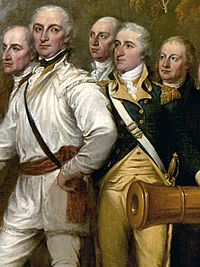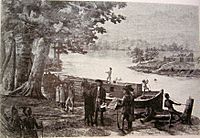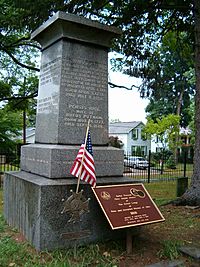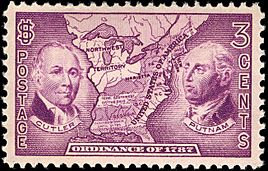Rufus Putnam facts for kids
Quick facts for kids
Rufus Putnam
|
|
|---|---|
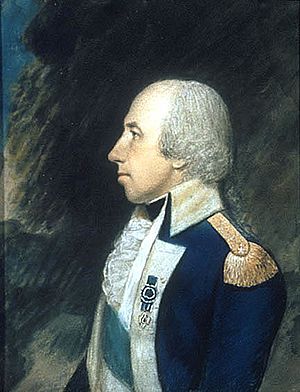
Rufus Putnam
|
|
| Born | April 9, 1738 Sutton, Massachusetts |
| Died | May 4, 1824 (aged 86) Marietta, Ohio |
| Place of burial | |
| Allegiance | |
| Service/ |
Continental Army US Army |
| Years of service | 1775–1783 (Continental Army) 1792–1793 (US Army) |
| Rank | |
| Relations | Persis Rice (wife) |
| Other work | pioneer to the Ohio Country; founder of Marietta, Ohio; judge of the Northwest Territory; first Surveyor General of the United States |
| Signature | |
Rufus Putnam (born April 9, 1738 – died May 4, 1824) was an important military leader in early American history. He fought in the French and Indian War and became a general in the Continental Army during the American Revolutionary War. After the war, he helped found the Ohio Company. This group was key in settling the Northwest Territory, which is now part of Ohio. He was often called the "Father of the Northwest Territory."
Contents
Early Life and Military Service
Rufus Putnam was born in Sutton, Massachusetts. When he was about six or seven years old, his father passed away. Rufus then lived for a short time with his grandfather. Later, he lived with his mother and stepfather in Sutton, where they ran an inn.
Serving in the French and Indian War
From 1757 to 1760, Putnam served as a soldier for Connecticut during the French and Indian War. He fought in areas around the Great Lakes and near Lake Champlain. This experience taught him a lot about military engineering.
Life After the War
After the French and Indian War, Putnam moved to New Braintree, Massachusetts. From 1761 to 1768, he worked as a millwright, building and repairing mills. He became very well-known for his skills.
Marriage and Family Life
In April 1761, Rufus Putnam married Elizabeth Ayers. She passed away in 1762. On January 10, 1765, he married Persis Rice. They had a family together.
Becoming a Farmer and Surveyor
Even while working as a millwright, Putnam spent his free time learning. He studied geography, mathematics, and surveying. In 1769, he became a farmer and a surveyor.
In 1773, Rufus Putnam traveled with his cousin, Israel Putnam, and others. They went to survey land near Pensacola, Florida. There, Putnam mapped lands along the Mississippi River. The King of England planned to give these lands to soldiers who had fought in the French and Indian War.
Revolutionary War Hero
When the Battle of Lexington and Concord happened on April 19, 1775, Putnam joined one of Massachusetts' first revolutionary groups. He later became a Lieutenant Colonel in the Continental Army. His regiment first fought the British Army in Roxbury, Massachusetts.
Fortifying Boston
After the battles of Lexington and Concord and Battle of Bunker Hill, the Americans surrounded the British in Boston. This siege lasted for many months. Neither side could make much progress. Rufus Putnam used his experience from the French and Indian War to build strong defenses. He built fortifications in Roxbury and other key places.
He studied a book called Attack and Defense of Fortified Places to learn more. Using these ideas, Putnam created a plan to fortify Dorchester Heights. This area overlooked Boston Harbor. Even though the ground was frozen in March 1776, Putnam's plan worked. His troops used timbers and fascines (bundles of sticks) to build defenses overnight. The next day, cannons brought by Henry Knox were placed there. The British were surprised and found themselves in a very bad position. This forced them to leave Boston by sea in the following weeks.
Building Fortifications in New York
General Washington then made Putnam the Chief of Engineers for the defenses in New York. Putnam was promoted to colonel. He led the building of forts that helped win battles at Sewall's Point, Providence, Newport, Long Island, and West Point.
In December 1776, Putnam briefly resigned when Congress didn't approve his idea for a national engineering group. But he soon rejoined the Continental Army. He served under Major General Horatio Gates and commanded two regiments in the battle of Saratoga. He continued to build important forts, including Fort Putnam at West Point in 1778. In January 1783, he was made a brigadier general.
Life After the War
After the war, Putnam returned to Rutland, Massachusetts. He had bought a farm there that was taken from a Loyalist (someone loyal to Britain). He went back to working as a surveyor, checking lands in Maine. Putnam strongly believed that soldiers who fought in the Revolution should be given land.
He was also a founding member of the Society of the Cincinnati. This group was for officers who served in the Continental Army. He also helped the Leicester Academy in Leicester, Massachusetts.
The Ohio Company
Putnam's belief in giving land to veterans led him to help create the Ohio Company of Associates. This company was formed to buy and settle lands in the West. He started the company in Boston on March 3, 1786, with Benjamin Tupper, Samuel Holden Parsons, and Manasseh Cutler. Their main goal was to settle the Northwest Territory. This land was given to the U.S. by Great Britain after the Treaty of Paris (1783).
After the Northwest Ordinance was passed (a law to organize the territory), the Company bought about 1,000,000 acres (4,000 km2) of land. This land was north of the Ohio River, between what are now Marietta, Ohio, and Huntington, West Virginia.
Later Years and Legacy
In 1788, Putnam led a group of Revolutionary War veterans to settle this new land in Ohio. These pioneers arrived where the Ohio and Muskingum rivers meet on April 7, 1788. They founded Marietta, Ohio. This was the first permanent United States settlement by European-Americans in the Northwest Territory. Putnam was appointed as one of the three judges for the Northwest Territory.
The land had been home to Native American tribes for a long time. As more pioneers arrived, conflicts began. Native American tribes formed a group to try and remove the Americans from their lands.
From 1792 to 1793, Putnam served as a brigadier general in Anthony Wayne's Ohio campaign. This campaign was against Native American tribes like the Shawnee, Lenape, and Seneca. The tribes were eventually defeated.
In 1796, the President appointed Putnam as the first Surveyor General of the United States. He held this job until 1803. As Ohio prepared to become a state, Putnam was chosen as a delegate for Washington County to the Ohio Constitutional Convention (1802) in 1802.
He also served as a Trustee for Ohio University from 1804 to 1824. In 1808, Putnam was elected the first Grand Master of the Grand Lodge of Free & Accepted Masons of Ohio, a fraternal organization.
Rufus Putnam passed away on May 4, 1824. He was buried at Mound Cemetery in Marietta, Ohio.
Honors and Recognition
- Rufus Putnam is shown on a commemorative stamp issued on July 13, 1937. This stamp celebrated the 150th anniversary of the Northwest Ordinance of 1787.
- Putnam's home in Marietta is a National Historic Landmark.
- His home in Rutland, Massachusetts, called the General Rufus Putnam House, is on the National Register of Historic Homes.
- The town of Putnam, Ohio (now part of Zanesville, Ohio) was named after him.
- Fort Putnam, which he helped build, is part of the U.S. Military Academy at West Point, New York.
- One of his grandsons, Catharinus Putnam Buckingham, became a brigadier general in the Union Army during the American Civil War.


